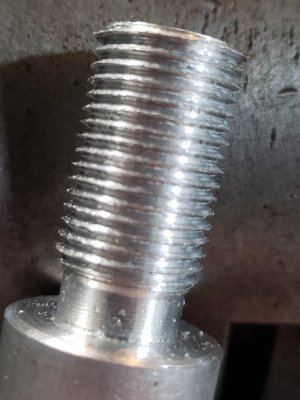- Joined
- Dec 18, 2019
- Messages
- 7,430
Agree with @jwmelvin looks like you were off the timing mark a few times. If you can slow it down, practice just getting engagement on the mark every time. What matters is consistency. Later you can speed it up as your consistency improves. It's developing eye hand coordination as well as muscle memory.
Some of the crests have additional cuts in them which shows inconsistent timing of lead screw engagement. You can see them if you zoom way in to your picture. When you get it right the threads will appear a lot cleaner. You are almost there!
Some of the crests have additional cuts in them which shows inconsistent timing of lead screw engagement. You can see them if you zoom way in to your picture. When you get it right the threads will appear a lot cleaner. You are almost there!

